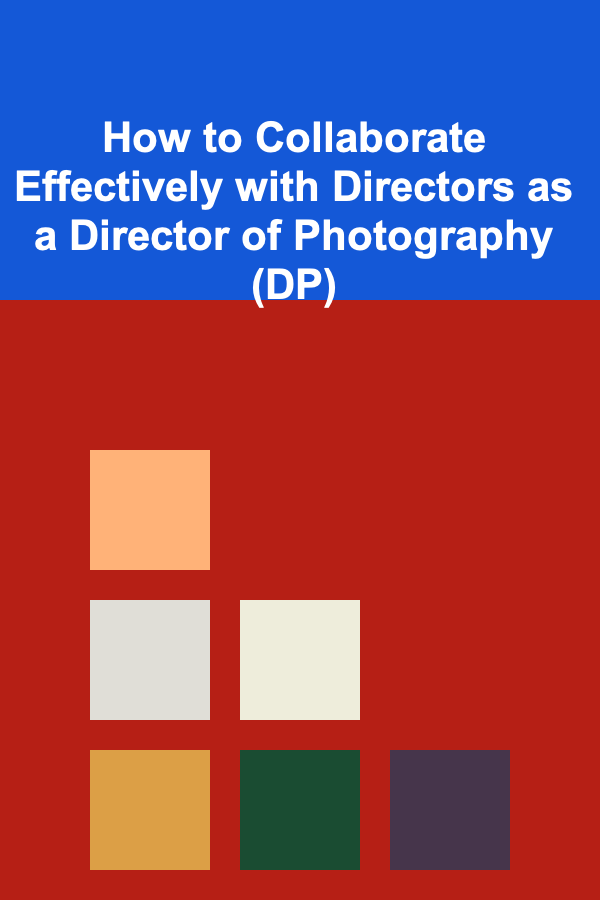
How to Collaborate Effectively with Directors as a Director of Photography (DP)
ebook include PDF & Audio bundle (Micro Guide)
$12.99$5.99
Limited Time Offer! Order within the next:

The role of a Director of Photography (DP), also known as the Cinematographer, is one of the most creative and integral parts of a film production. The DP is responsible for the visual style, lighting, and camera work of a film, television show, or commercial. This means that, as a DP, you must not only have technical expertise and creative vision but also the ability to collaborate effectively with the director. The relationship between the DP and the director is one of the most important dynamics on set, as both roles work hand-in-hand to bring the story to life visually.
Effective collaboration between the DP and the director is crucial for the success of a project, ensuring that the director's vision is realized and that the visual elements complement the narrative. However, this collaboration is not always easy. It involves balancing creative differences, understanding each other's perspectives, and working towards a common goal. In this article, we will explore the best practices for DPs to collaborate effectively with directors, focusing on communication, understanding the director's vision, and maintaining a productive working relationship throughout the production.
Understanding the Director's Vision
The first and most important aspect of collaborating with a director is understanding their vision for the project. A director has a specific idea of how the story should be told, the emotions that should be conveyed, and the visual tone that should be established. As a DP, it is essential that you align with the director's vision while also offering your expertise and creative input to enhance it.
Discuss the Script and Themes
Before you start planning any shots, have an in-depth discussion with the director about the script. Understand the key themes, emotions, and story beats that the director wants to highlight. Pay attention to the character arcs, the setting, and the mood that the director is trying to evoke. By doing so, you will be better equipped to translate these ideas into the visual language of the film.
Visual References and Pre-Visualization
Directors often have visual references, such as paintings, photographs, or other films, that they believe capture the tone they want to achieve. Encourage the director to share these references with you early in the pre-production phase. This can give you a clearer understanding of their aesthetic preferences and the kind of visuals they have in mind.
Pre-visualization tools, such as storyboards or shot lists, are also incredibly helpful. The DP and director can work together to create these visual plans before shooting begins, ensuring that both parties are on the same page about the look and feel of the film.
Flexibility and Open Dialogue
While understanding the director's vision is crucial, it is equally important to maintain flexibility. Sometimes, creative ideas may evolve or change on set. As a DP, you must remain open to changes and suggestions from the director. An effective collaboration is not about rigidly adhering to initial plans but being responsive and adaptive as the director's vision evolves.
Establishing Clear Communication
Clear and consistent communication is the foundation of a successful collaboration between the DP and the director. Miscommunication can lead to misunderstandings, missed opportunities, or, worse, poor-quality shots that do not align with the director's intentions. Here are some key aspects of communication that can improve collaboration:
Active Listening
As a DP, it is essential to practice active listening when communicating with the director. When the director explains their vision or gives feedback, listen carefully and ask follow-up questions to ensure you understand their intent. This shows respect for their ideas and helps avoid any confusion later in the production process.
Regular Meetings and Check-Ins
Throughout the production process, regular check-ins with the director are essential. These meetings allow you to discuss progress, share updates, and address any concerns. Whether it's during pre-production, rehearsals, or on set, maintaining ongoing communication ensures that you are always aligned with the director's evolving needs.
Constructive Feedback
There will be times when the director offers feedback on the shots, lighting, or camera work. When this happens, it is important for the DP to remain open to constructive criticism. Approach feedback with a problem-solving mindset, thinking about how you can make adjustments to better serve the director's vision. Similarly, be prepared to offer constructive suggestions to the director, particularly if you believe a change in the shot or lighting will benefit the scene.
Use of Visual Language
Since filmmaking is a visual medium, much of the communication between the DP and the director will be done through visual language. It's important that both of you share a common understanding of what certain visual choices mean. For example, a high-angle shot might represent power or dominance, while a close-up can signify intimacy or vulnerability. By discussing these visual motifs with the director, you ensure that your camera work enhances the story's narrative and emotional impact.
Balancing Creative Differences
It is natural for a director and DP to have different ideas about how to approach a scene. After all, the director has their own vision, while the DP brings their own artistic perspective and expertise to the table. How you navigate these differences can significantly impact the success of the collaboration.
Respecting the Director's Authority
While collaboration is important, it's essential for the DP to respect the director's role as the overall decision-maker. As the director is the person responsible for the entire creative direction of the project, their vision must ultimately take precedence. If there are disagreements, try to approach the situation professionally and respectfully. Voice your concerns or ideas, but also acknowledge that the director's decisions are final.
Offering Solutions Instead of Problems
When you encounter a challenge or creative difference, don't just point out the problem---offer solutions. For example, if you believe that a particular shot isn't achieving the desired effect, suggest alternative ways to achieve the same result. By presenting options, you show your creativity and flexibility, while also respecting the director's decision-making process.
Find Compromise
Sometimes, collaboration requires finding a middle ground. There may be instances when the director's vision and your ideas don't align exactly. In these cases, it's important to find a compromise that satisfies both parties. This might mean adjusting the lighting, framing, or shot selection in ways that align with the director's overall vision while still incorporating your creative input.
Fostering Trust and Respect
Trust and respect are the cornerstones of any successful creative collaboration. As a DP, it is essential that you build and maintain a trusting relationship with the director. This will allow for a more productive working environment and will enable you to take risks and experiment with ideas that may enhance the project.
Demonstrating Competence and Confidence
The director needs to trust that the DP has the technical expertise to execute their vision. By demonstrating competence in your craft---whether it's through your knowledge of lighting, camera work, or post-production techniques---you show the director that you can bring their vision to life. Confidence in your ability as a DP will help the director feel more comfortable allowing you creative freedom within their project.
Collaborating with the Director's Vision, Not Just Their Instructions
While following the director's instructions is essential, the best collaborations occur when the DP contributes creatively, aligning their work with the director's overall vision while enhancing it. Approach your work with the mindset that your role is not simply to execute tasks but to contribute to the larger story in a meaningful way.
Supporting the Director's Emotional Investment
Filmmaking is an emotionally intense process. Directors often pour their heart and soul into a project, and they can feel vulnerable when it comes to sharing their vision with others. As a DP, you must support and encourage the director, particularly during stressful moments. Acknowledge the director's emotional investment and offer reassurance when necessary. Your support will foster an environment where both of you can thrive creatively.
Practical Considerations and On-Set Collaboration
Beyond the creative and emotional aspects of the collaboration, there are also practical considerations that need to be addressed on set. A smooth, efficient production is often the result of effective collaboration between the director and the DP.
Prepping the Crew
As the DP, you are often responsible for leading the camera and lighting crew. It's essential to ensure that your team is well-prepared and aligned with the director's vision. Before shooting begins, hold a meeting with the director and the crew to go over the shot list, lighting setups, and any specific instructions. Clear communication with the team ensures that everyone is on the same page and reduces the likelihood of errors or delays.
Problem-Solving During the Shoot
On set, things don't always go as planned. Unexpected challenges often arise, whether it's due to technical issues, changes in weather, or time constraints. When these problems occur, it's important for the DP and director to work together to find solutions quickly. Stay calm, think critically, and collaborate to come up with a solution that keeps the production moving forward.
Efficiency and Time Management
Both the DP and the director need to be mindful of time management on set. Filmmaking is a time-intensive process, and staying on schedule is essential. Collaborate with the director to ensure that shots are set up efficiently, lighting adjustments are made quickly, and rehearsals are concise. Your ability to manage time effectively and work within the director's parameters will contribute to a successful shoot.
Post-Production Collaboration
While the DP's role is most prominent during production, collaboration with the director continues into post-production. In post-production, the director and DP work together to finalize the visual style of the film, including color grading, visual effects, and editing.
Color Grading and Look Development
Color grading is one of the key aspects of post-production where the director and DP work closely together. The DP may have specific ideas about how the film's color palette should look, and the director's feedback will guide the final adjustments. This is where the visual style of the film truly comes together, so it's important to maintain a close working relationship during this stage.
Visual Effects and Integration
If the project involves visual effects, the DP and director must collaborate closely with the VFX team. The DP's knowledge of camera angles, lighting setups, and shot composition will be essential for ensuring that the effects blend seamlessly with the live-action footage.
Conclusion
Collaboration between the DP and the director is one of the most important relationships on a film set. By understanding the director's vision, establishing clear communication, balancing creative differences, and fostering trust and respect, the DP can contribute to the successful realization of the director's creative ideas. Filmmaking is a team effort, and when the DP and director work together harmoniously, the result is a more dynamic and visually stunning film that resonates with audiences. Effective collaboration is not just about technical skill, but about building a strong, productive partnership that elevates the entire project.

How to Design a Checklist for Improving Customer Service Efficiency
Read More
How to Plan a DIY Craft Party for Creative Guests
Read More
How to Secure Paid Podcast Guest Appearances
Read More
How to Turn Your Basement into a Functional Living Space
Read More
Navigating the Complexities of Content Marketing: Best Practices and Innovations for Managers
Read More
How To Master Robot Vision for Object Recognition
Read MoreOther Products

How to Design a Checklist for Improving Customer Service Efficiency
Read More
How to Plan a DIY Craft Party for Creative Guests
Read More
How to Secure Paid Podcast Guest Appearances
Read More
How to Turn Your Basement into a Functional Living Space
Read More
Navigating the Complexities of Content Marketing: Best Practices and Innovations for Managers
Read More